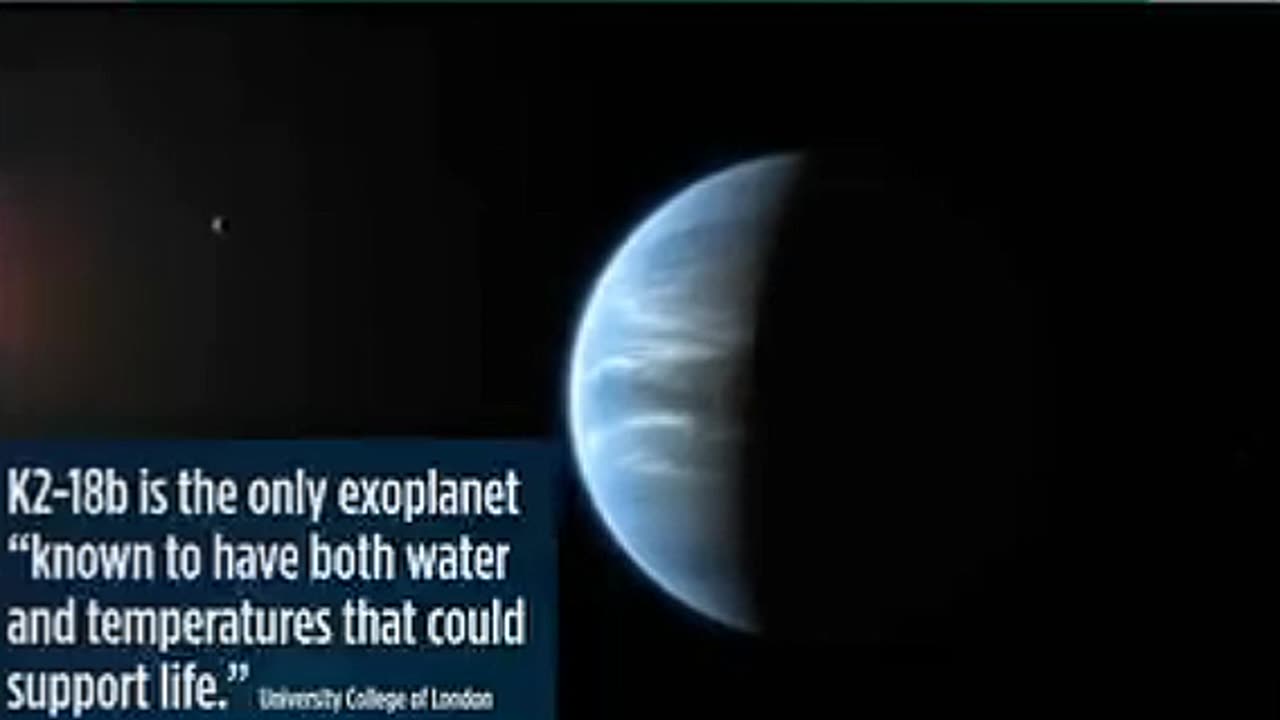Premium Only Content

K2~18B
Scientists find 'strongest evidence yet' of life on distant planet. K2-18b is two-and-a-half times the size of Earth and is 700 trillion miles, or 124 light years, away from us - a distance far beyond what any human could travel in a lifetime.
JWST is so powerful that it can analyse the chemical composition of the planet's atmosphere from the light that passes through from the small red Sun it orbits.
The Cambridge group has found that the atmosphere seems to contain the chemical signature of at least one of two molecules that are associated with life: dimethyl sulphide (DMS) and dimethyl disulphide (DMDS). On Earth, these gases are produced by marine phytoplankton and bacteria.
Prof Madhusudhan said he was surprised by how much gas was apparently detected during a single observation window.
"The amount we estimate of this gas in the atmosphere is thousands of times higher than what we have on Earth," he said.
"So, if the association with life is real, then this planet will be teeming with life," he added.
Prof Madhusudhan went further: "If we confirm that there is life on K2-18b, it should basically confirm that life is very common in the galaxy."
He told BBC Radio 5Live on Thursday: "This is a very important moment in science, but also very important to us as a species.
"If there is one example, and the universe being infinite, there is a chance for life on many more planets."
Dr Subir Sarkar, a lecturer in astrophysics at Cardiff University and part of the research team, said the research suggests K2-18b could have an ocean which could be potentially full of life - though he cautioned scientists "don't know for sure".
He added that the research team's work will continue to focus on looking for life on other planets: "Keep watching this space." gas giant with no surface.
Both these alternative interpretations have also been challenged by other groups on the grounds that they are inconsistent with the data from JWST, compounding the strong scientific debate surrounding K2-18b.
Prof Chris Lintott, presenter of the BBC's The Sky at Night, said he had "great admiration" for Prof Madhusudhan's team, but was treating the research with caution.
"I think we've got to be very careful about claiming that this is 'a moment' on the search to life. We've [had] such moments before," he told Today.
He said the research should be seen instead as "part of a huge effort to try and understand what's out there in the cosmos".
Prof Madhusudhan acknowledges that there is still a scientific mountain to climb if he is to answer one of the biggest questions in science. But he believes he and his team are on the right track.
"Decades from now, we may look back at this point in time and recognise it was when the living universe came within reach," he said.
"This could be the tipping point, where suddenly the fundamental question of whether we're alone in the universe is one we're capable of answering."
The research has been published in The Astrophysical Journal Letters. The search for life beyond Earth has led scientists to explore many suggestive mysteries, from plumes of methane on Mars to clouds of phosphine gas on Venus. But as far as we can tell, Earth’s inhabitants remain alone in the cosmos.
Now a team of researchers is offering what it contends is the strongest indication yet of extraterrestrial life, not in our solar system but on a massive planet, known as K2-18b, that orbits a star 120 light-years from Earth. A repeated analysis of the exoplanet’s atmosphere suggests an abundance of a molecule that on Earth has only one known source: living organisms such as marine algae.
“It is in no one’s interest to claim prematurely that we have detected life,” said Nikku Madhusudhan, an astronomer at the University of Cambridge and an author of the new study, at a news conference on Tuesday. Still, he said, the best explanation for his group’s observations is that K2-18b is covered with a warm ocean, brimming with life.
“This is a revolutionary moment,” Dr. Madhusudhan said. “It’s the first time humanity has seen potential biosignatures on a habitable planet.” No matter how the scientists revisited their readings, the signal stayed strong. They concluded that K2-18b may in fact harbor a tremendous supply of dimethyl sulfide in its atmosphere, thousands of times higher than the level found on Earth. This would suggest that its Hycean seas are brimming with life.
Other researchers emphasized that much research remained to be done. One question yet to be resolved is whether K2-18b is in fact a habitable, Hycean world as Dr. Madhusudhan’s team claims.
In a paper posted online Sunday, Dr. Glein and his colleagues argued that K2-18b could instead be a massive hunk of rock with a magma ocean and a thick, scorching hydrogen atmosphere — hardly conducive to life as we know it.
Scientists will also need to run laboratory experiments to make sense of the new study — to recreate the possible conditions on sub-Neptunes, for instance, to see whether dimethyl sulfide behaves there as it does on Earth. Co-author Måns Holmberg, a researcher at the Space Telescope Science Institute in Baltimore, USA, added: 'It was an incredible realisation seeing the results emerge and remain consistent throughout the extensive independent analyses and robustness tests.'
DMS and DMDS are molecules from the same chemical family, and both are predicted to be biosignatures.
Both molecules have overlapping spectral features in the observed wavelength range, although further observations will help differentiate between the two molecules.
'Our work is the starting point for all the investigations that are now needed to confirm and understand the implications of these exciting findings,' said co-author Savvas Constantinou, also from Cambridge's Institute of Astronomy.
The team say their observations have reached the 'three-sigma' level of statistical significance – meaning there is a 0.3 per cent probability that they occurred by chance.
To reach the accepted classification for scientific discovery, the observations would have to cross the five-sigma threshold, meaning there would be below a 0.00006 per cent probability they occurred by chance.
They said between 16 and 24 hours of follow-up observation time with JWST may help them reach the all-important five-sigma significance.
The discovery was published in the journal The Astrophysical Journal Letters. Trending
War on Gaza
Donald Trump
Sudan War
Russia-Ukraine War
EXPLAINER
News
|
Space
Is there life on another planet? Scientists find the strongest evidence yet
Near a planet far, far away, astronomers have found traces of chemicals that on Earth are only produced by living beings.
James Webb Space Telescope Images
The spiral galaxy NGC 2090, located in the constellation Columba seen through the NASA/ESA/CSA James Webb Space Telescope [Courtesy of NASA]
By Al Jazeera Staff
Published On 17 Apr 2025
17 Apr 2025
Save articles to read later and create your own reading list.
Astronomers have found the clearest evidence yet that life might exist beyond the solar system, from the atmosphere of a planet 124 light years away from Earth, setting off rare excitement – tinged with caution – in the global scientific community.
Using the James Webb Space Telescope, researchers led by astronomers at the University of Cambridge in the United Kingdom have found chemical signatures of two compounds that on Earth are only produced by living creatures.
RECOMMENDED STORIES
list of 4 items
list 1 of 4
Space cowboys: The maverick pioneers of galactic travel
list 2 of 4
ISS astronauts take cover as defunct Russian satellite shatters
list 3 of 4
US space agency NASA releases Webb telescope photos of entwined galaxies
list 4 of 4
Artificial solar eclipse: Why are satellites trying to block the sun?
end of list
“These are the first hints we are seeing of an alien world that is possibly inhabited,” Nikku Madhusudhan, an astronomy professor at Cambridge and the lead researcher behind the discovery, told reporters at a media briefing on April 15. “This is a revolutionary moment.”
So where is the planet that might possibly host life, what evidence have scientists found, and is there reason for scepticism?
Where did the scientists find this evidence?
The researchers relied on data captured by NASA’s James Webb telescope, which was carried into outer space in 2022, and sits about 1.5 million kilometres (930,000 miles) away from Earth, as humanity’s watchtower peering into the universe.
Advertisement
They focused on one particular planet, K2-18b, because it had already shown promising signs as a candidate extraterrestrial body with conditions similar to those on Earth.
Sign up for Al Jazeera
Americas Coverage Newsletter
US politics, Canada’s multiculturalism, South America’s geopolitical rise—we bring you the stories that matter.
E-mail address
Subscribe
By signing up, you agree to our Privacy Policy
protected by reCAPTCHA
K2-18b lies in a constellation called Leo, and is so far away from Earth that a spaceship would need to travel for 124 years at the speed of light to get there. In reality, it would take much, much longer since the laws of physics don’t allow anything other than light to travel that fast.
The planet is 8.6 times heavier than Earth, and 2.6 times as large. Critically, it sits in what is known as the “Goldilocks Zone” of its sun: that’s the region around a star where a planet’s temperature could, in theory, support water in its liquid form on the surface.
In 2023, Cambridge astronomers found methane and carbon dioxide in the atmosphere of the planet.
That was the first time that carbon-based molecules had been discovered in the atmosphere of any planet in the habitable zone of its sun – the distance from a sun where it’s neither too hot, nor too cold, and so possible for life to survive. The scientists said that a surface covered first by an ocean, and then a hydrogen-rich atmosphere, would explain the presence of carbon-based molecules. Simply put, it was possible that the planet could have water.
What have the scientists found now?
Researchers have now found much harder evidence suggesting that the planet might not only have the conditions to host life – but could, at least in theory, be hosting life itself. K2-18b isumba umubumbe w'Isi incuro zibiri n'igice ikaba iri ku birometero birenga imiriyaridi 1.000.000 uvuye kuri uno mubumbe w'isi turiko.
Telescope JWST irakomeye cane ku buryo ishobora gusuzuma ibinyabutabire bigize ikirere c'uno mubumbe ikoresheje umuco w'izuba ukirabirizamwo.
Uno murwi w'abahinga ba Cambridge watoye ko iki kirere gisa n'igifise ibimenyetso nibura vya kamwe mu dukaba tubiri dufitaniye isano n'ubuzima: imyuka (gas) dimethyl sulphide (DMS) na dimethyl disulphide (DMDS). Ku mubumbe w'Isi, aya magaze ava mu vyimeza n'udukoko dutoduto vyo mu mazi.
Prof Madhusudhan avuga ko yatangajwe n'urugero rw'iyi myuka rwabonetse mu mwihwezo umwe wonyene.
Ati: "Urugero rw'iyi myuka tubona ruri muri ico kirere rusumba incuro ibihumbi n'ibihumbi iyo dufise kw'Isi.
"Rero, nimba vy'ukuri iri sano n'ubuzima ari iry'ukuri, vyumvikana ko ubuzima bushoboka kuri uno mubumbe".
Prof Madhusudhan avuga kandi ati: "Nitwamara kwemeza ko ubuzima bushoboka kuri K2-18b, vyoba bigaragaye ko ubuzima ari ikintu gisanzwe cane mu gisokoro c'ibinyenyeri [galaxie]". An ocean world teeming with alien life may exist 124 light years away from Earth, a study by Cambridge University has hinted.
The exoplanet K2-18b, which exists in the constellation Leo, appears to have an atmosphere containing huge quantities of dimethyl sulfide, a chemical only produced by living organisms such as marine phytoplankton.
Advertisement
Quantities of the chemical are so great that it represents 20 times the biological activity of Earth. The molecule vanishes fairly quickly, suggesting something is continuing to produce it.
Astrophysicists at Cambridge University have described the findings as a “huge, transformational moment” and the strongest hint yet that life exists elsewhere in the universe.
Prof Nikku Madhusudhan, from Cambridge’s Institute of Astronomy, said: “There is no mechanism that can explain what we are seeing without life.
“Given everything we know about this planet, a world with an ocean that is teeming with life is the scenario that best fits the data we have.
He added: “What we are seeing right now are the first hints of an alien world that is possibly inhabited, and this is a revolutionary moment.”
K2-18b is about 2.6 times the size of Earth and exists in the so-called Goldilocks Zone of its star, where conditions are neither too hot, nor too cold, for life.
/storage/emulated/0/Download/google6170e9d15902cb37 (6).html
-
 UPCOMING
UPCOMING
Wendy Bell Radio
4 hours agoThe Party Of Workers
2.52K32 -
 LIVE
LIVE
LFA TV
2 hours agoLFA TV ALL DAY STREAM - TUESDAY 9/2/25
14,240 watching -
 1:27:10
1:27:10
JULIE GREEN MINISTRIES
2 hours agoLIVE WITH JULIE
41.8K106 -
 LIVE
LIVE
The Bubba Army
4 days agoChicago BloodBath! 54 Shot, 7 Dead- Bubba the Love Sponge® Show | 9/02/25
5,494 watching -
 LIVE
LIVE
BEK TV
3 days agoTrent Loos in the Morning - 9/2/2025
220 watching -
 10:47
10:47
Nikko Ortiz
18 hours ago15 Seconds Of Fame Gone WRONG...
124K14 -
 14:47
14:47
GritsGG
1 day agoRumble Tournament Dubular! Rebirth Island Custom Tournament!
83.9K5 -
 1:36:05
1:36:05
Side Scrollers Podcast
21 hours agoStreamer ATTACKS Men Then Cries Victim + Pronoun Rant Anniversary + More | Side Scrollers
93.5K13 -
 LIVE
LIVE
Lofi Girl
2 years agoSynthwave Radio 🌌 - beats to chill/game to
248 watching -
 42:55
42:55
Stephen Gardner
1 day ago🔥Trump’s SURPRISE Move STUNS Everyone - Democrats PANIC!
118K130